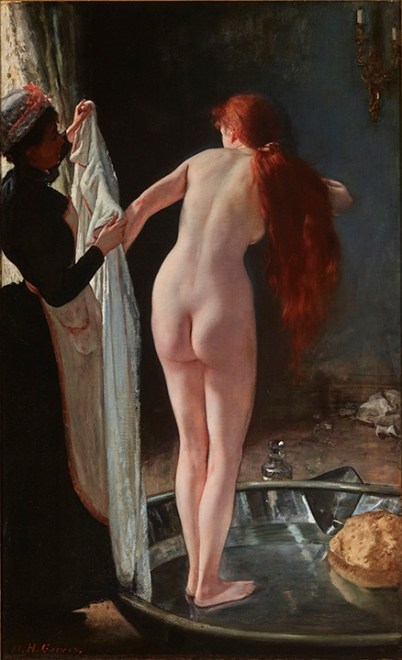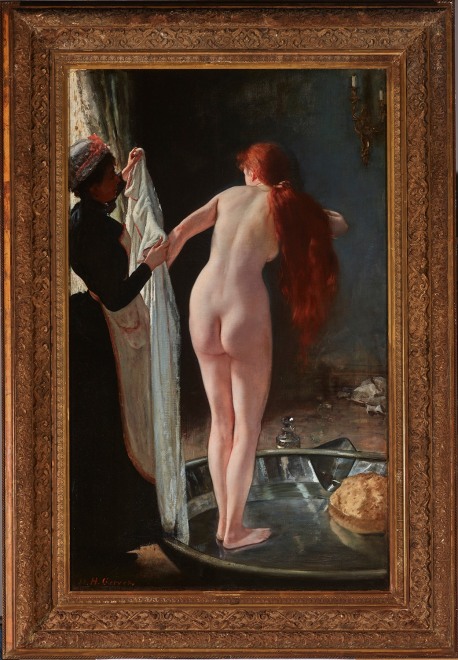Provenance
Private collection, New York
Exhibited
Paris, Salon, 1888, no. 1114
Literature
Anonymous, “Courrier de Paris,” L'Univers illustré, journal hebdomadaire, 12 May 1888, p. 290
Anonymous, “Salon de 1888,” La Revue indépendante, vol. 7, 1888, p. 420
Jehan de l’Estrange, “Le Salon,” La France chorale, moniteur des Orphéons, 16 June 1888, np.
René Doumic, “Le Salon de 1888,” Le Correspondant, vol. 115, 1888, p.549
Louis Enault, “Le Salon,” La Revue diplomatique et le moniteur des consulats, 5 May 1888, p. 8
Henri Fouquier, “Le Salon Illustré, Paris, Baschet, vol.1, no. 4, 15 June 1888, pp. 12-13, ill. p. 17
Henri Fouquier, “Le Salon,” Gil Blas, no. 3065, 9 May 1888, p. 1
Henry Fouquier, “Le Salon,” Le XIXe siècle, journal quotidien politique et littéraire, 1 May 1888, p 2
Marcel Fouquier, “Salon de 1888,” La Nouvelle Revue, vol. 52, May-June 1888, p. 642-3
Grosclaude, “L'eau et ses usages,” L'illustration, 3 November 1888, p. 318
Hugues Le Roux, “Le Tour du Salon,” Le Temps, 1 May 1888, n.p.
Parisis, “Le Vernissage,” in Le Figaro, no. 122, 1 May 1888, p. 1
Paul Montès, “A travers les salles,” Journal des artistes, 3 June 1888, p. 181
Claude Philipps, “The Salon,” in The Magazine of Art, vol. 11, 1888, p. 343
E. M. Rashdall, “The Salon, 1888,” The Artist, 1 June 1888, p.174
Paul Rouaix, “Le Salon,” La Revue de famille, 1 June 1888, p. 169
Armand Silvestre, “Salon de 1888,” La Revue de Paris et de Saint-Petersbourg, no. 9, June 1888, p.44
M. G. Soé, “Salon de 1888,” Revue littéraire et artistique du centre, 1888, p. 195
Steck, “Au Salon,” La Vie parisienne, mœurs, 5 May 1888, p. 244
Pierre Véron, “Le Salon de 1888,” Le Journal Amusant, no. 1653, 5 May 1888, p. 2
Albert Wolff, Figaro-Salon, Paris, Boussod Valadon, 1888, p. 39
Ischmael, “French painters chez-eux,” The Illustrated American, September 6, 1890, p. 422
Henri Gervex, 1852-1929, exh. cat, Paris Musées, 1992, p. 47, 149
Catalogue note
It would not be inaccurate to describe Henri Gervex’s painting as sometimes “schizophrenic.” As a young artist, he was trained for five years in the studio of the premier Academic master, Alexandre Cabanel, while later in his career, he developed an affinity for the art of the Impressionist painters, notably Degas, Manet and Renoir. In fact, Gervex posed for one of the dancers in Renoir’s Bal du moulin de la Galette. What is important to note is that as he matured, Gervex never abandoned his Academic training and technique when depicting the female nude, clearly working in a style reminiscent of his teacher, Cabanel as well as other traditional painters such as Paul Baudry. One immediately recalls works such as Cabanel’s The Birth of Venus and Baudry’s The Pearl and the Wave. In other words, Gervex’s bather in our picture, as is the young prostitute Marion in his famous painting, Rolla, are both descended from Cabanel and Baudry’s nudes.
No subject was better suited for an Academically trained painter than the female nude. Perfected after rigorous practice in drawing technique working from a live model; the result for the very best traditional artists was life-like in its realism. In The Tub, Gervex paints a voluptuous young woman at her bath. She stands in a large zinc basin which includes a sponge and a bottle of perfumed bath oil. Her skin is soft, almost creamy with an air-brushed quality; this speaks to Gervex’s determination to paint a flawless finish. At the same time, Gervex cannot resist giving a nod to his Impressionist colleagues, especially Degas. We see this in the maid servant holding the white robe, who is painted with looser brushstrokes and less specific detail; this reveals Gervex’s interest in painting more impressionistic and less traditional in this part of the painting. In addition, the subject of a nude in a bathtub was an often-repeated theme in works by Degas.
The model in this newly discovered painting is most likely the famous Parisian courtesan, Valtesse de la Bigne, who inspired Zola’s novel, Nana and was linked with many of the most well-known literati and artists of the day, including Courbet, Boudin and Detaille. She and Gervex were lovers from 1876 to around 1880. Known for her trademark cascading red hair, Valtesse would often pose for Gervex; the most well-known depiction is a full-length portrait of her standing in a garden (Musée d’Orsay, Paris). While our painting was shown at the 1888 Paris Salon, we will never be sure if Valtesse posed for Gervex at the time or if he immortalized her from the previous decade.




